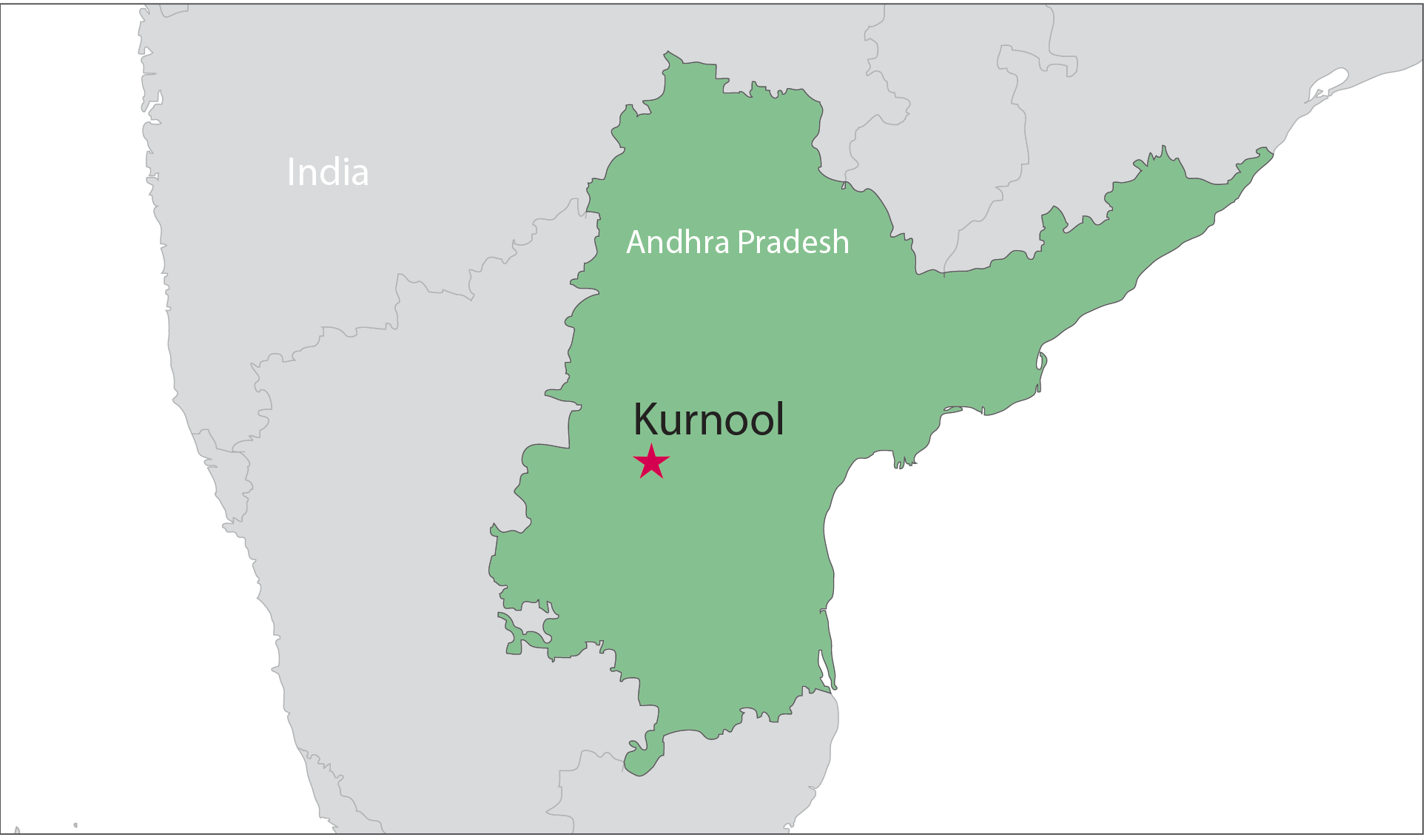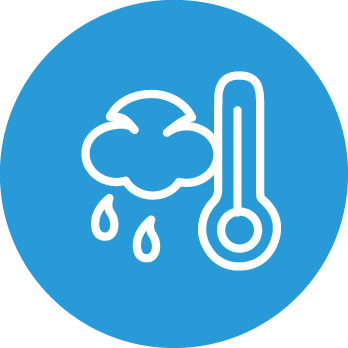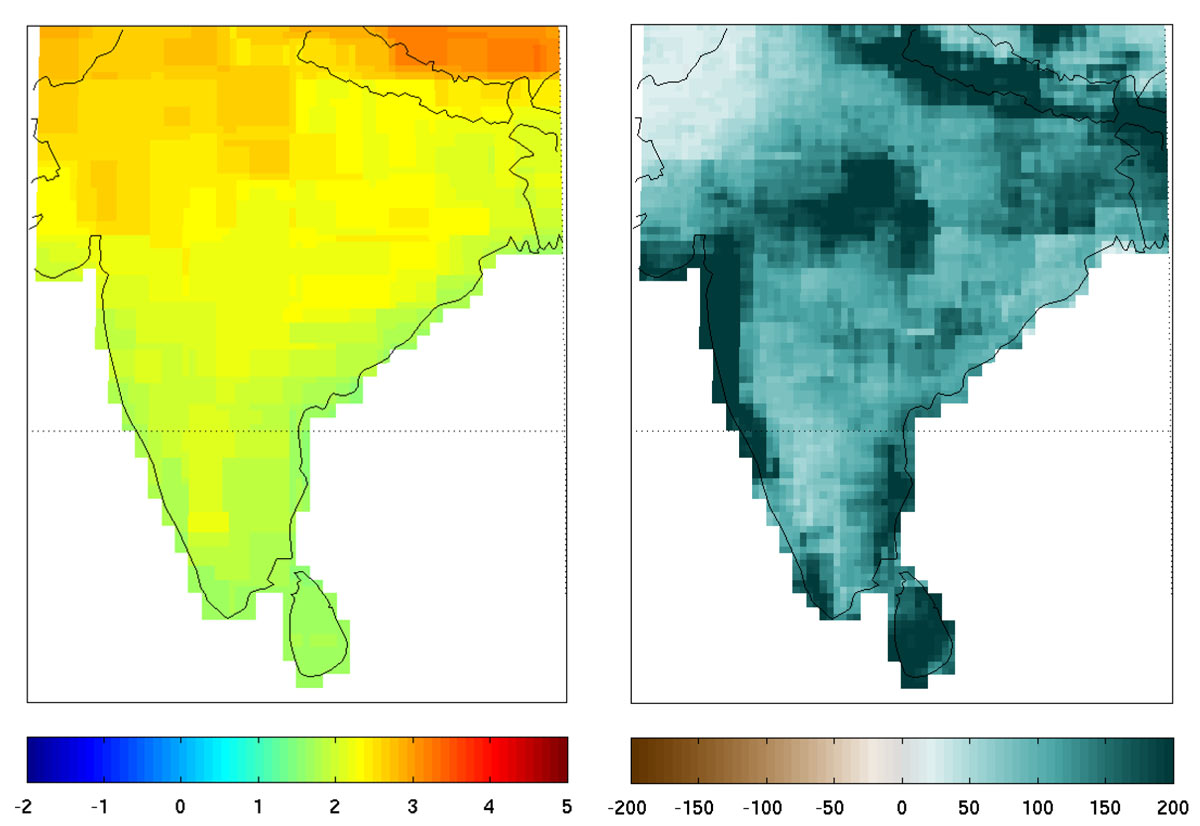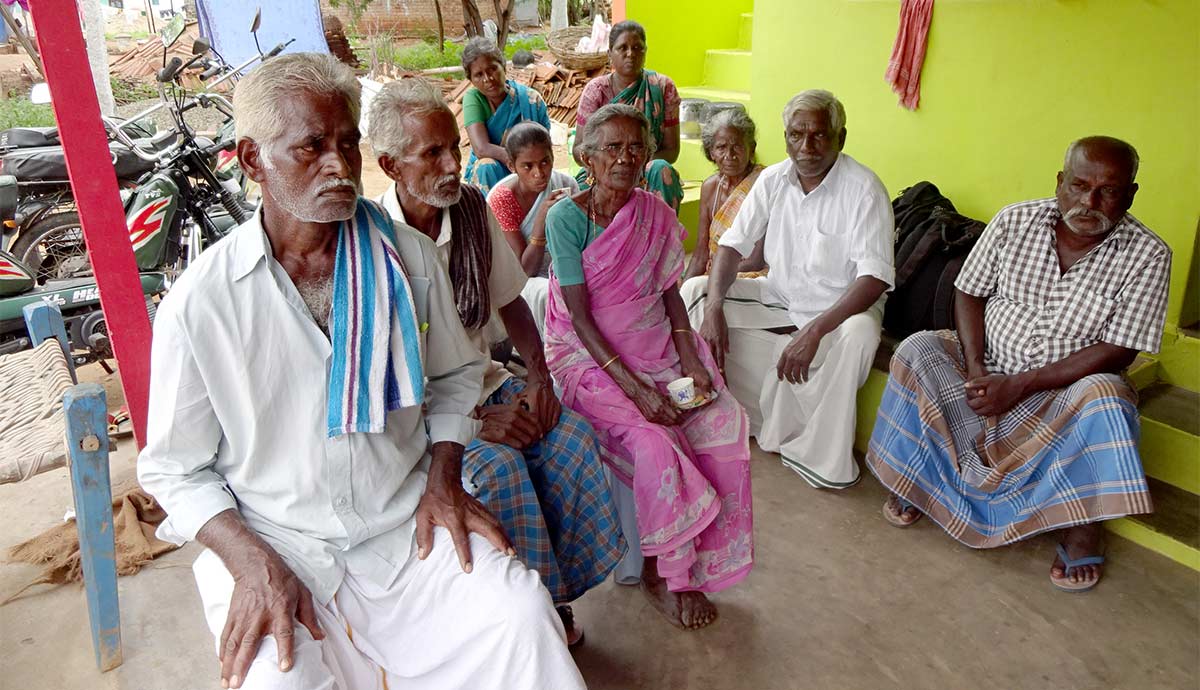Kurnool District, India
Adaptations for Fallow-Chickpea Cropping Systems

Current Farming System
Fallow-Chickpea Cropping System
Low rainfall and high rainfall zones
Black Cotton Soils
Semi-arid
Smallholder farms

CLIMATE 2050s
Temperature could increase up to .5 to 3°C
Rainfall could increase by 6.4%-37.8%

Impacts
Cool-wet and cool-dry climate scenarios have a positive impact on chickpea yield
Hot-dry and hot-wet climate scenarios have a negative impact

VULNERABILITY 2050s
62% of farms could be vulnerable to the impacts of climate change
Per capita income decreases by 12% in the hot/dry climate model

Adaptations
An adaptation package including a new chickpea cultivar with drought tolerant traits, sustainable water management, improved fertilizer application, and increased mechanization could benefit more than 70% of farms
 Results Overview
Results Overview
The potential impacts climate change and possible adaptations may have on fallow-chickpea cropping systems in South India are examined in this study. In particular, the study focuses on the Kurnool district of Andhra Pradesh, India. The main occupation and source of livelihood for this district is agriculture. More than 70% of the 4.04 million people in the Kurnool district engage in farming. Kurnool is predominantly farmed via rainfed agriculture. The majority of the farm households follow a "fallow-chickpea" cropping system.
In this study, farming households are divided into two categories and are examined as: low rainfall region, and medium/high rainfall region. These categories are determined by amount of annual precipitation as well as ease of access to alternate irrigation sources. The low rainfall regions, located in the western part of Kurnool district, average less than 500 mm of rainfall per year. Agriculture here is rainfed; there are no irrigation sources like canals, rivers, or open wells in the region. In the medium and high rainfall regions, located in the eastern part of Kurnool, annual rainfall averages between 700-800 mm. These regions also contain canal water sources that can be used for irrigation.
All climate models used in this study predict the Kurnool district will average higher (warmer) temperatures in the 2050s. The higher emission scenarios project warmer temperatures than the lower emission scenarios. Additionally, compared to current climate, both the moderate and high emissions futures predict more precipitation in wet scenarios and less precipitation in drier scenarios compared to the current levels in the crop-growing season (post rainy season; June to November). Though all projections generally predict increased rainfall, there is clear variation across models: 3%-27% higher rainfall under the mid-range climate scenario, and 6%-40% higher rainfall across five climate scenarios.
 Map of Kurnool District in India
Map of Kurnool District in India
The impact of climate change on the Kurnool district's rainfed agriculture suggests negative impacts to the fallow-chickpea farming system in pessimistic climate scenarios (i.e. hot-dry) and positive impacts in optimistic climate scenarios (cool-wet). Categorically, it is clear that the impacts of climate change are comparatively higher in the high rainfall region than in the low rainfall region. Future projections suggest that increased precipitation in the low rainfall regions will more significantly increase chickpea yields than the adverse impacts from higher temperature. More precipitation following the rainy season will increase soil moisture and decrease risk of drought and yield loss.
Findings suggest that the majority of fallow-chickpea farm households are vulnerable (64% in warmer climate and 48% in wet climate) to climate change under current production systems. However, climate impacts vary across the region. For example, the pessimistic climate scenario (hot and dry) suggests farmers in high rainfall regions will be considerable more vulnerable than low rainfall region farmers. The negative impacts of chickpea yields in warmer climate scenarios will be more significant in the high rainfall region than in the low rainfall region.
A large proportion of the farming population can benefit from adopting current ‘climate-smart' adaptations and can help shift a significant percentage of the population from vulnerable status to resilient status. The package includes interventions such as promoting location specific varieties (short duration variety in low rainfall region and medium duration variety in high rainfall region), providing critical irrigation using harvested rainwater, using recommended fertilizer application, introducing a new crop (foxtail millet) during the kharif season to enhance the system productivity, and adopting mechanical harvesters to reduce harvesting cost.
When future adaptation efforts are considered, models suggest chickpea yields will decrease under warmer climate scenarios but increase under wet scenarios. Economic impacts vary as well; warm scenarios predict aggregate negative impacts (more than 60% of households is projected to be vulnerable), while wet scenarios predict aggregate positive economic impacts (less than 50% of households is projected to be vulnerable). Comparatively, a lower percentage of farm households are vulnerable in the future when compared to today. This is because although warmer climates will reduce the total chickpea yield, prices will most likely be higher in the future – due to lower chickpea availability. This will therefore offset the negative impacts on yield.
Despite the aggregate outcomes, there are subpopulations of farms that may remain vulnerable in the future. In particular, farms located in areas with high maize potential are at significant risk of negative economic impacts. Maize is predicted to have significant yield reductions in the hot/dry climate scenarios. High maize potential areas are heavily reliant on maize for income and predicted future prices do not benefit the farmer.
The majority of farmers in the Kurnool region can significantly benefit from adopting intervention packages in the future. The adaptation package includes improved cultivars, micro irrigation systems with improved water use efficiency, and the application of fertilizer alternatives. The changes in maize management will increase yields and offset the negative impacts from climate change.
 Farming System
Farming System

Chickpea farm in Kurnool
Andhra Pradesh's Kurnool District is located in the west-central part of the state. It lies between 140 54' and 160 18'N and 760 58' and 790 34'E and averages an altitude of above 100 feet. The Tungabhadra and Krishna rivers and Mahabubnagar district bound Kurnool on the north, the Prakasam district in the east, Kadapa and Anantapur districts on the south, and Bellary district of Karnataka State on the west. A total of 40,53,463 persons populate the district's 17,658 sq. kilometers. Kurnool is 8th in terms of population and 3rd in terms of area in the state as per 2011 census. Agriculture, mostly rainfed, has been the main livelihood occupation of the farmers in the district.
Andhra Pradesh is divided into seven Agro-climatic zones. The Kurnool district is identified under the scarce rainfall zone (VI) with an annual rainfall of 500 to 750 mm. More than 80% of the agricultural area is under rainfed farming systems. The average rainfall received in Kurnool district is approximately 670 mm. The South West Monsoon and North East Monsoon supply nearly all of the annual rainfall (68% and 22%, respectively). Rainfall in Kurnool district is mostly erratic, insufficient and unevenly distributed. Hence, droughts or floods are a common problem in the district.
Agriculture in the Kurnool district is predominantly a "fallow-chickpea" cropping system. The major crops grown in the district are chickpea, groundnuts, sunflower, rice, sorghum, cotton, pigeonpea, black gram, and onions. Over the last twenty years, there has been significant shift in crops grown. Low rainfall, labor scarcity, increasing wage rates, and a lack of available irrigation sources has encouraged farmers to farm water efficient rainfed crops that require minimal labor. As a result, the amount of land dedicated to chickpea, groundnuts, and sunflower has increased. In 1991-1993, only 2.45% of farmed land grew chickpea but by 2008-2010, that percentage had increased to 23%. Chickpea, groundnuts (20.8%), sunflower (12.3%), and rice (12.7%) are the major crops in the region.
Crops are cultivated during the kharif (rainy) season from June-October, and the rabi (post-rainy) season from November to February. The major crops grown in rainy season are paddy, cotton and pigeonpea. In post-rainy season, chickpea, sorghum and sunflower are predominantly grown. Because black soils make it difficult to cultivate during the rainy season, the ‘fallow-chickpea' cropping system is the dominant cropping system. Additionally, most of the farm household rear livestock in the backyard and the most common livestock are buffaloes, cow, sheep and goat. The farmers feed the livestock with crop residues and also graze the livestock in the common lands in the dry season.
 Climate Change Projections
Climate Change Projections

Median changes in June-September growing season (left) temperature (oC) and (right) total precipitation (mm) from 29 climate model simulations for India and surrounding countries in South Asia in the 2050s under a high emissions climate change scenario, compared with the 1980-2010 historical period.
Generally, the array of 29 climate models used in this analysis projected substantial warming over the Kurnool district. Most of the climate models showed overall precipitation increases in both the low and high rainfall regions evaluated. These projections are considered for the entire year, given that this study evaluated chickpea-based systems during the summer and fall growing periods. The five focus models selected predicted temperature changes ranging from 0.51˚C -1.93˚C under the mid-range moderate emission scenario, and 0.46˚C - 3.0˚C under the worst-case high emission scenario. Though generally increased, rainfall percent changes show much variation across models: 2.9%-26.7% greater rainfall under the moderate emission scenario, and 6.4%-37.8% greater rainfall under the high scenario. These future climate scenarios are also characterized by higher carbon dioxide concentrations (e.g. 571 ppm in the RCP8.5 scenario), which may further interact with the temperature and precipitation changes to impact plant growth and cropping system responses. The array of models used will help in improving assessments of future crop production and food security and will assist in informing adaptive planning.
 Climate Change Impacts
Climate Change Impacts
Results of crop model projections for the 2050s
Current System
If farmers continue their practices today in the future, chickpea yields are projected to decrease under hot conditions due to heat and water stress. Conversely, cool conditions (cool/wet, cool/dry) are projected to have a positive impact on chickpea yields. In high emissions future, chickpea yields in the low rainfall regions ranges from -17% to 49%. In the high rainfall zone, chickpea yields are predicted to be negative in hot-dry, hot-wet, and middle climate scenarios.
Future System
The pessimistic climate scenarios like hot-dry, cool-dry and hot-wet scenarios have negative impacts of climate change on chickpea yields and optimistic scenario cool-wet has positive impacts of climate change.
 Vulnerability
Vulnerability
Current System
In a moderate emission future, with hot-dry scenarios the farm households in the high rainfall region are highly impacted by climate change when compared to farm households in low rainfall region based on model simulation.
Under a moderate emissions future, farmers in the Kurnool district will be vulnerable to climate change if they continue to use their current farming systems. Generally, farmers in the high rainfall regions are more vulnerable to impacts than in low rainfall regions, though the difference is small. Approximately 62% of households in the high rainfall region, and approximately 58% of farmers in the low rainfall region, are vulnerable in the hot-dry scenario. Chickpea yields are expected to reduce because of extreme heat stress, and the net change in yield is more significant for high rainfall region farmers than low region farmers.
In a high emission future, vulnerability in a hot/dry scenario is projected to be 67% of all farm households in the Kurnool district. In a cool/wet scenario, this changes to 47% of high rainfall region farmers and 34% low rainfall region farmers being vulnerable.
Future System
When looking at farm vulnerability under a future farming system and a "green" development pathway (see below), farmers are still susceptible to climate impacts. In a dry scenario, approximately 62% of the farming population is projected to be vulnerable, while only 47% is expected in a more favorable, wet scenario. Interestingly, the impacts on vulnerability will be less significant if chickpea prices are low.
In a future farming system and a "grey" development pathway (see below), vulnerability is slightly higher than the "green" road. Vulnerability impacts farmers in the high rainfall region more than low rainfall region farmers. Because of favorable climate, i.e. with high rainfall and with one additional irrigation given by the farms in the low rainfall regions, the crop yields increase significantly for all the farms which reduces the farm vulnerability in the high price scenario.
The price sensitivity revealed that in wet climate scenario (cool-wet), the per capita income increase is low (7.5%) in low price scenario compared to high price scenario (9.5%) but percent change in poverty in high (12%) in lower price scenario than high price scenario (9%).
RAP Sustainable development - The Green Road
Under the Green Road RAP development, India's future could continue in the progressive path of successfully implementing the National Mission on Sustainable Agriculture coupled with reform in key sectors such as energy, land, and water use – which are crucial for sustainable intensification in agriculture. The State's primary sector mission may provide a holistic approach including economic and ecological objectives as it works to enhance sector productivity and incomes of farm households across the state. This mission may promote the adoption of resource efficient technologies and practices for production and post-harvest handling. The state could experience inclusive growth enabled by the improved access to financial services for a large number of smallholder farmers. This access could be provided through SHGs as well as other collective action based models such as farmer producer companies and cooperatives. An ecosystem services based governance of natural resources may help ensure environmental sustainability. In general the state Government investment on public health, education, skill development and rural infrastructure can slow the population growth rate and improve household welfare.
RAP Fossil fuel development - The Grey Road
Under this development road, increased population growth, growing demand for food and fuel, and the lowered research and development investment from the state government in developing resource efficient and high yielding technologies could lead to over exploitation of land and water resources. There could be low adoption of productivity enhancing technologies due to limited access to financial services. Slow and ineffective reforms could delay process in energy, water and land lease leading to highly inequitable distribution of resources. Inadequate infrastructure and low skill levels in rural areas may lead to high post losses and lower opportunities for non- farm employment, further reduces household income. Low-investment on health and education in rural areas could lead to migration of unskilled labor to urban areas increasing poverty and nutrition insecurity.
 Adaptation
Adaptation
Adaptation packages for current period
Climate variability and the inconsistent distribution of rainfall across the Kurnool district is the biggest challenge rainfed farmers face today. Climate variability has increased in recent decades and to reduce negative impacts of variability, the AgMIP South India team developed adaptation packages with regional stakeholders. These adaptation packages encourage farming systems to adopt climate smart and resilience focused farming methods. Regional stakeholders included representatives included members of the Department of Agriculture, regional research institutions, local farmers, local extension workers, and more. The developed adaptation package included the use of genetic improvements of crop yields, improved management practices, and the use of new crops, like small millet, to increase farming intensifications.
The study suggests about 80% of farmers would adopt this climate adaptation package. More farmers in the low rainfall region (85%) will adopt the package, as the package includes installing irrigation ponds that will help farmers during dry spells. These ponds could improve chickpea yields by as much as 60%. Poverty rate may also decrease when adopting these pacakges, it is projected the poverty rate may change by 16% and 15% for low rainfall farmers and hig rainfall farmsm respectively.
Adaptation packages for future period
To reduce climate vulnerability and increase resiliency for farmers in the future, the AgMIP South India team developed region specific adaptation packages. These packages predominantly focus on incorporating drought and heat-tolerant traits into high yielding varieties of chickpea.
When examining future adaptation in the Green road, the adaptation package specifically includes: incorporating high yielding varieties of chickpea with drought and heat tolerant traits, 5 tons/ha of manure application for chickpea in both regions, and improving irrigation methods and application. More specifically, applying 90mm of micro-irrigated water three times a day in high rainfall region farms, and 50mm micro-irrigated water four times a day on low rainfall region farms. The benefit to the adaptation package in the Green road is clear: more than 70% of farmers could adopt the adaptation package and benefit from the adoption.
The Grey road adaptation package differs from the Green road package. In this package, lack of resources limit the development of chickpea varieties. Consequently, a cultivar with 15% higher yields is integrated, along with the use of 30kg/ha of nitrogen fertilizer and an irrigation program consisting of three applications of 50, 50, and 30 mm of water from inefficient irrigation systems. While this adaptation package will benefit farmers, the rate of adoption is relatively low compared to the Green road package.
Results
In a Green Road future with moderate emissions the adaptation package (chickpea cultivar with drought and tolerant traits with good irrigation and fertilizer management) could be adopted by more than 70% of farms.
The adoption rate of new an adapted system in a future world is higher in the harsh climate scenarios then the favorable climate.
In a Grey Road future with high emission scenarios and chickpea cultivar without drought and heat tolerant traits, the adoption rate of new system is low compare to Green Road. There is not variation in adoption rate among the climate scenarios.
 Stakeholder Engagement
Stakeholder Engagement

Stakeholder engagement workshop with Kurnool farmers.
Climate change adaptation involves assessment of complex processes of impacts of climate, economy and policy with multiple dimensions cutting across local, regional, national and global scales.
Stakeholder engagement played a significant role in AgMIP's research in the Kurnool district. Climate change's impacts and adaptation strategy is multidimensional and involves assessing complex processes of climate, economy, and policy. To ensure efforts from various disciplines converged to develop comprehensive plans, the AgMIP South India team utilized a transdiciplinary approach to their research and integrated assessments. This approach ensured stakeholders provided and developed research initiatives throughout the project.
The AgMIP South India team engaged with an array of stakeholders throughout the research project. In particular, staekholders were involved during the development of Andrha Pradesh RAPs, the development of adaptation packages for chickpea farming systems, and the up-scaling of policy and decision support systems to a wider audience.
The stakeholders engaged during this project included: government representatives from the Department of Agriculture (Andhra Pradesh) and the Environmental Protection Training and Research Institute (EPTRI); chickpea farmers from the Kurnool district; development agencies and national banks including representatives from the National Bank for Agriculture and Rural Development (NABARD). These stakeholders valuably contributed to and improve research outputs valuable contributions
 Learn More
Learn More
This research was made possible by generous support from the UK Department for International Development's UKaid.
This research is a part of the AgMIP Southern Inida project; more information is available here.
South India Team Members:
| Vellingiri Geethalakshmi | Principal Investigator |
| Dakshina Murthy | Co-PI, Crop modeling, Stakeholder liaison |
| Ponnusamy Paramasivam | Economics |
| Swamikannu Nedumaran | Economics |
| D. Kumara Charyulu | Stakeholder engagement |
| Arunachalam Lakshmanan | Stakeholder engagement |
Affiliated Institutions
Indian Council of Agricultural Research – Indian Institute of Farming (ICAR-IIFSR) The Bangladesh Agricultural Research Council The Nepal Agricultural Research Council The International Maize and Wheat Improvement Center (CIMMYT) Indian Council of Agricultural Research – National Dairy Research Institute Indian Council of Agricultural Research – Agricultural Technology Application Research Institute, Jodhpur
References
Antle, J.M., R.O. Valdivia, K. Boote, S. Janssen, J.W. Jones, C.H. Porter, C. Rosenzweig, A.C. Ruane, and P.J. Thorburn, 2015: AgMIP's transdisciplinary agricultural systems approach to regional integrated assessment of climate impacts, vulnerability, and adaptation. In: Rosenzweig C., and D. Hillel (eds) Handbook of Climate Change and Agroecosystems: The Agricultural Model Intercomparison and Improvement Project (AgMIP). ICP Series on Climate Change Impacts, Adaptation, and Mitigation Vol. 3. Part 1, Imperial College Press, 27-44, doi:10.1142/9781783265640_0002.
Rosenzweig C., J.W. Jones, J.L. Hatfield, A.C. Ruane, K.J. Boote, P. Thorburn, J.M. Antle, G.C. Nelson, C. Porter, S. Janssen, S. Asseng, B. Basso, F. Ewert, D. Wallach, G. Baigorria, and J.M. Winter, 2013: The Agricultural Model Intercomparison and Improvement Project (AgMIP): Protocols and Pilot Studies. Ag. For. Meteor., 170, 166-182. http://dx.doi.org/10.1016/j.agrformet.2012.09.011
Ruane, A.C., and S. McDermid, 2017: Selection of a representative subset of global climate models that captures the profile of regional changes for integrated climate impacts assessment. Earth Perspectives, In review.
Singh P, Nedumaran S, Boote KJ, Gaur PM, Srinivas K, and Bantilan MCS. 2014. Climate change impacts and potential benefits of drought and heat tolerance in chickpea in South Asia and East Africa. European Journal of Agronomy 52: 123–137
